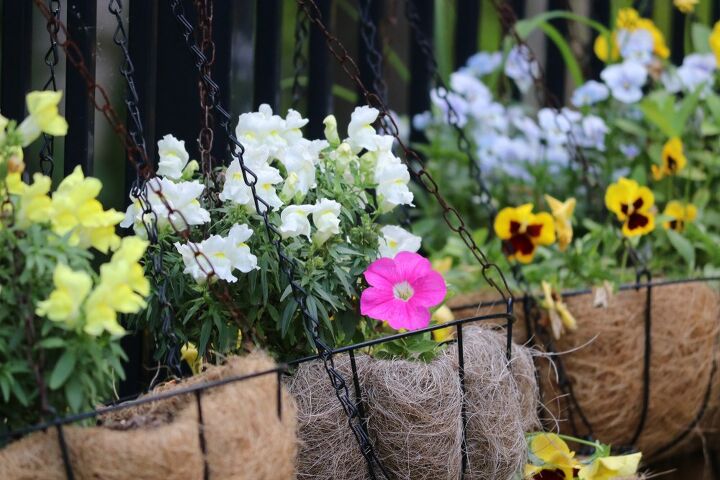Flowers That Can Survive A Spring Frost

The saying goes “April showers bring May flowers,” but that is assuming that the showers don’t result in an overnight frost. Spring is an unpredictable season of extremes in many regions. Temperatures can reach in the high 70s and even low 80s, prompting flowers to bloom. But days later, these fresh blooms may shrivel and die because of an unexpected overnight frost. This is why if you live in a seasonal climate, it is a wise idea to plant flowers that can survive a spring frost.
If you live in a climate where there are overnight frosts in the spring months, you should opt for flowering plants that can survive temperatures below freezing. Some popular spring flowers that can withstand overnight frosts include snapdragons, pansies, geraniums, petunias, and daffodils. Some less popular but equally resilient spring flowers include dianthus, primrose, sweet alyssum, calendula, and coneflowers. Consider planting more vulnerable spring flowers in movable pots.
If you live in a region that experiences the highs and lows of a turbulent spring season, make sure you keep reading. It is heartbreaking to watch your spring flowers bloom for a day or two, only to watch them swiftly die because of a spring frost. The best way to avoid this premature death of your beautiful spring blooms is to consider planting some flowers that can withstand frosty nights such as the ones listed below.
13 Flowers That Can Survive A Spring Frost
1. Geranium
Geraniums are technically a perennial species but are commonly planted as annuals. These popular hearty plants love direct sunlight and flourish in any area with nutrient-rich soil. They are popular hanging plants as well, as they love light and are relatively low-maintenance. These flowers come in several colors, and while they can’t handle a deep freeze, they can tolerate a brief spring frost.
2. Lily Of The Valley
Not only does this plant have one of the most enchanting names, but it also has charming and delicate bell-like flowers to match. Lily of the Valley is a shrub that produces small but resilient white bell-shaped flowers from its stalks.
These flowers might look very fragile, but this plant is anything but, and is quite frost tolerant. Keep in mind that Lily of the Valley is toxic when consumed and potentially deadly for humans and is not a safe plant for dogs or other pets.
3. Petunia
There are more than 20 species of Petunias, and while they are common in warm areas, these flowering plants love cool weather. They are another species that does well as a hanging plant and are quite popular in window boxes. While this makes them easy to bring inside during an overnight frost, they are also frost-tolerant plants.
4. Snapdragons
One of the most colorful, fun, and unique flowers of spring is the snapdragon. These plants are real show-stoppers with their unique “bite-sized” flowers that grow upwards on each stalk. They give bursts of various colors to any garden you find them in. They can also tolerate temperatures as low as 25 degrees. This is why it is not uncommon to see snapdragons survive even after a brief spring snowstorm.
5. Primrose
The primrose might have a dainty look to it, but believe it or not, this plant is one of the most resilient in cold weather. It can grow as an annual or perennial and likes to bloom in early spring and in the fall, when cold weather makes evening appearances. It is a great option for anyone looking for a flower that blooms in early spring and can withstand some particularly cold evenings.
6. Pansies
Pansies are a whimsical and wildly popular flower to plant in the spring. Don’t be fooled by their seemingly delicate petals; these flowers can resist and survive night-time frosts that occur in the spring. Winter pansies are particularly resilient, and a great choice for those in cooler climates.
Pansies make great ground cover, as they don’t climb or grow high. Instead, they provide vibrant blooms that can be blue, red, cream, and even purple-colored.
7. Dianthus
If you are looking for a charming pink flower that will survive through spring and all its unpredictability, consider the dianthus. There are more than 300 varieties of this plant, and while they may have many different shapes and multiple colors, they are known to be vibrant and pink. These flowers love full sun, and like others on this list, they can tolerate a bit of frost.
8. Sweet Alyssum
If you want a spring flower that not only adds bright colors to your garden, but also has a sweet smell, then consider the honey aroma of the sweet alyssum. These cloud-like clustered white flowers give off an intoxicating sweet smell. They love lots of sun, and plenty of water as well. This makes them a great choice for those who have wet springs that might even turn frosty.
9. Daffodil
There are few flowers more emblematic of spring than daffodils. These quintessential yellow blooms are one of the first optimistic and lovely signs of spring. It should come as no surprise that these early bloomers are also tolerant of frost and below-freezing temperatures .
While they don’t like prolonged freezing (no flowers do), they can tolerate brief and gradual cold evenings and light frost, and still grow back each year.
10. Viola
The viola is a member of the violet family, and just like the violet, it produces stunning purple flowers. These flowers are found all over the world, from Hawaii to the Andes, as there are more than 600 species. Make sure you choose a cold-tolerant variety if you live somewhere with spring frost. Many of these cold weather varieties can handle frost and even deep freezes for brief periods.
11. Cone Flower
The coneflower is another fantastic spring flower that comes back year after year. This perennial can produce many different-colored flowers in the spring, and even the fall. They are also quite frost-tolerant. You can plant several different varieties at different times to have a variety of colors in your garden throughout the spring, even if there are cold snaps.
12. Coreopsis
Coreopsis might not be a household name or one that rolls off the tongue, but it is a great option for those who live in areas with harsh springs. Not only is this a frost-tolerant flowering plant, but it’s a real firecracker to add to your garden. The flowers offer rich orange, red, and yellow hues, which add lots of brightness to your spring landscape. It is also a perennial plant, so even if it dies off in an early autumn freeze, it will resurrect itself in the early spring.
13. Calendula
Calendula is a member of the daisy family, and this is quite apparent in the shape and silhouette of this flower. But unlike the daisy and its signature white petals, the calendula has yellow to orange petals. Another distinguishing characteristic of the calendula is that it can withstand occasional spring frosts. This makes it a great option for those who like the look of a daisy but live in frost-prone areas.
Final Notes On Flowers That Can Survive A Spring Frost
Spring is a time for rebirth, blooming, and the warming of the earth. It can also feature some weather extremes that can play dangerous tricks on spring flowers. Weather can turn from warm and sunny to cold and frosty in a matter of hours in some regions. This is why planting frost-tolerant spring flowers is essential for those who live in these types of areas. Luckily, many popular spring flowers are frost tolerant. Daffodils, snapdragons, cone flowers, pansies, petunias, and geraniums are all great options. You can also opt for less-popular species including calendula, sweet alyssum, or dianthus.
Related Guides:

Tom Gaffey is an expert writer who currently resides in Washington D.C. Tom has a passion for real estate and home improvement writing, as well as travel and lifestyle writing. He lived the last twelve years in Hawaii where he worked closely with luxury resorts and event planners, mastering his knowledge of aesthetics and luxury products. This is where he found his passion for home improvement and a keen interest in DIY projects. Currently, Tom resides in Washington D.C, and also working on his debut fiction novel.
More by Tom Gaffey



























